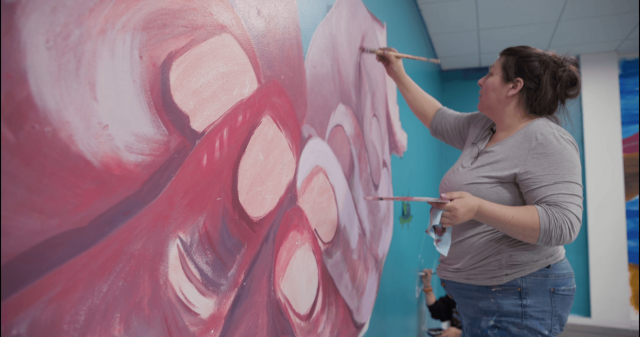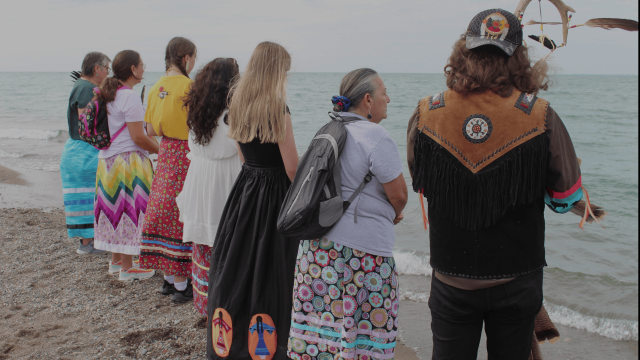The Indigenous Youth, Art and Water Initiative – A New Wave of Indigenous Leadership

Last week, One Drop’s headquarters became a vibrant space where the voices of young Indigenous leaders were not only heard—they were celebrated and amplified. For three days, we had the honour of co-hosting, alongside the Centre for Indigenous Environmental Resources (CIER), a group of remarkable ambassadors from regions across Canada. These youth spent over a year developing solutions, sparking conversations, and advocating for the protection of water—a vital element that holds deep cultural, spiritual, and environmental significance. It was an opportunity to honour their dedication, listen to their stories, and recognize the impact of their work.
Access to the very essence of life—safe water—remains a challenge for numerous Indigenous communities Canada-wide. This is why in 2023, One Drop and the Centre for Indigenous Environmental Resources (CIER) launched the Indigenous Water Allyship: a long-term program to improve living conditions and health in First Nations, Métis, and Inuit communities in Canada. The first phase of this program—the Indigenous Youth, Art and Water Initiative (IYAWI)—is meant to empower Indigenous youth to express their voices and visions around water-related challenges by leaning into art and community-based approaches.
Through a blend of traditional and contemporary art forms, young leaders reminded us that water is not just a resource—it’s a living entity that connects us all.
"Water is life. Without a healthy water system, plants, the ground, and humans suffer,” says JD Steuer, Young Indigenous Ambassador from Caldwell First Nation. “Our project achieved the first youth-led water walk in over 150 years, and we hope to see more water ceremonies worldwide, bringing healing to the waters."

Photo Credit: Caldwell First Nation













Youth and community members from Serpent River First Nation, Ontario explored their connections to water through PhotoVoice art, creating a map and booklet from water testing along the Serpent River to address pollution and cultural loss due to uranium contamination. This initiative—led by Quinn Meawasige and Norah Jacobs with support from The Waterways Collective—seeks to raise awareness and inspire action. Photo credit: CIER/The Waterways Collective

Youth and community members from Serpent River First Nation, Ontario explored their connections to water through PhotoVoice art, creating a map and booklet from water testing along the Serpent River to address pollution and cultural loss due to uranium contamination. This initiative—led by Quinn Meawasige and Norah Jacobs with support from The Waterways Collective—seeks to raise awareness and inspire action. Photo credit: CIER/The Waterways Collective

At École Iguarsivik in Puvirnituq, Quebec, a youth-led mural on water issues was created in collaboration with Inuit artist Niap, alongside the development of educational kits addressing water challenges, health, and cultural practices. This initiative was guided by Young Indigenous Ambassadors Elaisa Ittukallak and Natalie Tukalak with the support of Kativik Ilisarniliriniq. Photo credit: CIER/Kativik Ilisarniliriniq
In Six Nations of the Grand River, Ontario, the Ohneganos platform was indigenized to address the environmental as well as health impacts of water pollution and climate change. Media artwork and VR experiences focused on ecological grief were also crafted. This initiative was guided by Young Indigenous Ambassador Makasa Looking Horse and supported by the Indigenous Elders and Youth Council.

In Nuu-Chah-Nulth Territory, British Columbia, youth collaborated with Elders and master carvers to create a social art piece while sharing intergenerational knowledge. Leadership in sustainable marine protection and cultural revitalization was the focus of this endeavour, which was led by Young Indigenous Ambassadors Jessie (Lakos) Everson and Andrew Clappis with the support of the Nuu-chah-nulth Youth Warrior Family Society. Photo credit: CIER/Nuu-Chah-Nulth Youth Warrior Family Society

A social art exhibition hosted in Winnipeg, Manitoba engaged youth from various communities to create works reflecting personal connections to water and the impacts of climate change. This initiative was shaped by Young Indigenous Ambassadors Victoria Redsun and Paige Miswagon with the support of WAG-Qaumajuq. Photo: Courtesy of WAG-Qaumajuq

A mural displayed on Parliament Hill celebrated National Indigenous Water Operator Day, showcasing artwork by Indigenous youth and recognizing the contributions of water operators. Young Indigenous Ambassador Mia Cook from Calgary, Alberta played a vital role in this tribute to water leaders with support from Water Movement. Photo credit: CIER/Water Movement

Along Lake Erie’s shores, youth organized a water song ceremony and water walk to address water quality degradation and reconnect with traditional cultural practices. Young Indigenous Ambassadors Anellah Orosz and JD Steuer spearheaded this effort with Caldwell First Nation supporting them. Photo credit: CIER/Caldwell First Nation
As the Young Ambassadors bring their projects to a close, exciting updates and fresh content will be shared in the months ahead—stay tuned!
We extend our deepest gratitude to the inspiring youth who took the lead in these remarkable initiatives, as well as to the Indigenous-led organizations whose unwavering support guided them along the way. A heartfelt thank-you also goes out to CIER and our founding Water Impact Partners—Keurig Dr Pepper Canada, Ovivo, and Power Corporation of Canada—whose generous support brought this vision to life. Together, we are fostering change and empowering the next generation of water leaders.
IYAWI is just the beginning of a larger program: the Indigenous Water Allyship. By 2030, the program envisions contributing to the well-being of at least 50 of Indigenous communities (First Nations, Inuit and Métis) in Canada by safeguarding the sustainable access to safe drinking water, source water protection and empowering community-led water governance.
